Graham Reid | | 6 min read
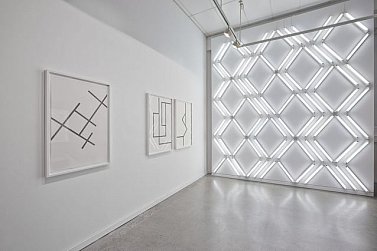
Bathed in the light from his wall-filling sculpture of fluorescent tubes, the Australian artist Jonathan Jones tells an insightful story.
When Governor Arthur Phillip was establishing Sydney in the late 18th century, the survey measure of a town was the number of its brick buildings. But because Sydney lacked a natural source of lime to mix with mortar it had none.
“So they were obsessed with getting bricks up and all they could do was dig up the [Aboriginal] middens to get the lime out. All those old shells hold the houses of Old Sydney Town together.
“I got interested in the idea that there are seams of commonality holding the bricks together to formulate Sydney’s identity. People always talk about Aboriginal history as being separate -- and yet here was something integrated and holding the fabric of Sydney together. It was a rare moment."
As an Aboriginal artist -- albeit one whose allusive, emotionally cool and minimalist work eschews the overly familiar dot and bark art, and the political polemic of some Aboriginal artists -- Jones has his work locates the invisible and the suggested, the spaces between overt meaning, and deep history.
“In Australia there’s a feverish and neurotic attempt to preserve anything that happened in the last 200 years as a way of formulating an identity and a historical narrative. But anything prior to that is not even on the radar.”
His anecdote is emblematic of how much of his thinking and work with light (and his drawings at the gallery) explores cultural and philosophical space, yet offers surfaces and images which can be read from multiple perspectives.
“I like the idea of not being too prescriptive and more suggestive, that everyone can take something to a work.”
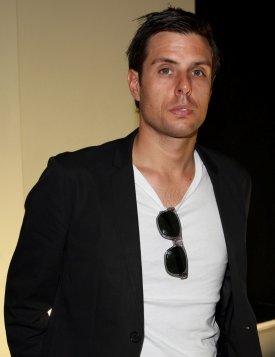 Jones admits sometimes what others bring has informed him in unexpected ways, except perhaps through some subconscious cultural memory. He tells of an old carver who, admiring the white geometrical patterns of his fluorescent work, said when people once carved shields they would rub them with white ochre which would become embedded in the grooves.
Jones admits sometimes what others bring has informed him in unexpected ways, except perhaps through some subconscious cultural memory. He tells of an old carver who, admiring the white geometrical patterns of his fluorescent work, said when people once carved shields they would rub them with white ochre which would become embedded in the grooves.
“So the actual design would be in white. No one of our generation has ever seen one of those objects finished with white ochre -- but that was his connection to the work and pushed it back into a more original context.”
Sydney-based Jones -- whose works are in the collections of Australia’s National Gallery in Canberra, the state galleries of New South Wales and Victoria as well as in private and corporate collections -- was drawn to working with light because the material were available, but then more so when a beloved auntie died.
At that time he was working with multiples and wanted to create something in which the separate elements were united into a whole: “The introduction of light was a way that could happen, there were these shiny metal things and when they were spot-lit they acted as one.”
“There was this referencing of my auntie and holding collective memory together, so she was there but not -- and while there was no tangible evidence [the individual elements] were connected [by the light]”.
Born in 1978, Jones has Kamilaroi and Waradjuri heritage and grew up moving between relatives’ houses near Tamworth and in Sydney: “One of those kids ignored enough that I could get away with jumping between the two places.”
At his auntie’s insistence he studied at a TAFE (“English for First Australians or something and maths for idiots, and an art component”, he laughs) and went to the University of New South Wales on an Aboriginal entry scheme. He graduated in 1999 by which time he had exhibited in a number of group shows.
Self-effacing, witty and acutely aware of the many agendas which can attend any contemporary Aboriginal, he has been accused sometimes of not using his position as a cultural ambassador or to be “screaming about the problems”.
“But even if you are screaming at someone they are not necessarily going to walk away with what you’ve screamed. Even if you work in text people will come away with own ideas.
“For some, Aboriginal art should be a vehicle for much more aggressive stances if you are lucky enough to get an audience, and most Aboriginal artists don’t.”
While he understands the argument to “forcefully educate”, he has been surrounded by supportive older artists whose own careers have allowed him to work in whatever way he chooses.
“[They] are much more relaxed about what the art can achieve, and about their place. Every show I’ve been in someone peddles something new about you, but it doesn’t bother me if someone picks up another reference opposed to an Aboriginal one.”
He also dismisses the suggestion that the whole dot art movement has been played out, and found out for the fraud that it can be when unscrupulous “dealers” buy and sell anything with a dot on it.
“Everyone says that, but every time I go to a community you see something you’ve never seen before and a whole new chain of events starts off and a new wave of innovation takes place. It is quite surreal.
“And you have got communities which are just starting to paint. They’ve been aware of all the other communities working, so to have a community take off now -- in their own direction, on their own terms and with all the knowledge of the others under their belts -- is very exciting.
“It reveals more creativity and more ingenuousness.”
His recent drawings -- like minimalist Suprematist work or elegantly spare abstracts -- have a backstory like the mortar of Old Sydney Town, or his light sculptures which draw symbolically on unifying disparate fields of the individual space into the whole, and the geometric patterns of Aboriginal weaponry among other things.
While in Northern India on a study grant he became curious about salt production, extending thoughts he was formulating because his family comes from near the progressively salinating Murray River “which is seriously compromised and affecting a whole suite of people.”
Tracing Gandhi’s steps on the 1930 march against the salt tax, he learned salt is now mostly sold to chemical plants and weapons manufacture, and in building industry.
His drawings reflect his mapping of “how salt has gone into this other world, but also mapping out the salt in the Murray, little maps so reductive they become anything.”
They also allude to light on the floor of temples he visited, “floor plans like salt plans, sort of road maps to [Gandhi’s] revolution too.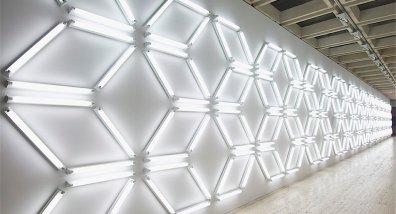
“I’m not sure that Aboriginal people are going to have a revolution but these are maybe about that connection to country that people have, and that maybe the country will do the revolution for the people.
“The country is turning on itself, the most productive area of Australia will soon die or not be in existence.”
And so goes the thinking and art of Jonathan Jones, taking the long view back and forward, alluding across spapce and time and cultures, locating unity in the seemingly separate, and illuminating the spaces between in the light from a florescent tube or on the white space on paper.

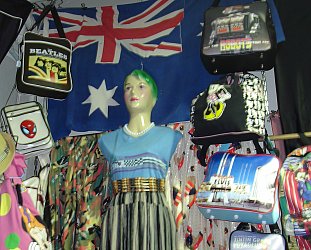



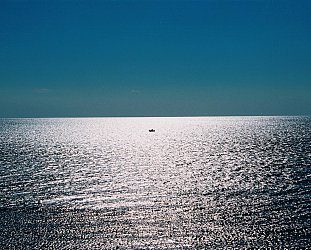
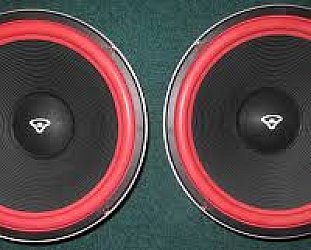
post a comment